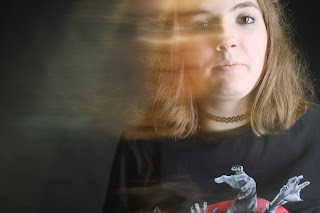Equipment Used:
Outdoors: Canon EOS 450D, standard lens.
Indoors: Canon EOS 450D, standard lens, soft box flash lights.
Settings:
Outdoors: 1/320, F/5.6, ISO 200.
Indoors: 1/125, F/11 or F/5.6, ISO 200.
Lighting:
Outdoors: Natural outdoor lighting.
Indoors: Model flash lighting.
Theory:
N/A.
Favourite:
Least Favourite:
This image is my favourite of this technique for a few reasons. Firstly, the exposure of the images worked well in allowing for the photos to combine although they were not too overexposed which could have lead to details in the portrait being lost. Additionally, the landscape captured was more detailed and interesting in shapes and tones than the below final outcome. Penultimately, the eye is the central focus of the photograph which was my aim. Finally, the section within the portrait where the section is missing I believe adds to the nature of the outcome.
Least Favourite:
This image is my least favourite as the subject was wearing a white top which meant that the nature of an over-exposed photograph meant that the outline of the subject was lost when the image was layered in Photoshop. Also, the landscape used did not have as many interesting texture and so on when compared to the above image.
Evaluation and Development -
This series is again of varied degrees of success. For instance, some images worked very successfully but the limited number of photographs I took that could later be combined resulted in limited options for the creation of the final pieces of the series. Furthermore, due to inability to plan to the extend that I would had this been a photoshoot of mine the subjects and landscapes used were those that were available to me within the immediate vicinity. Consequently, the aesthetic is not of my usual liking and I would have liked to explore ideas more similar to the work of Dan Mountford.
There is a possibility that I will use this techniques in my fashion/ surrealism project; as many artists within the surrealism genre experiment with multiple images combined through techniques such as collage, multiple exposure or multiple flash.





















































